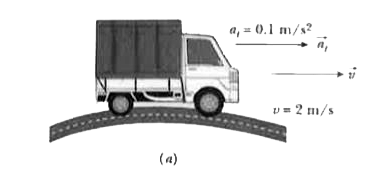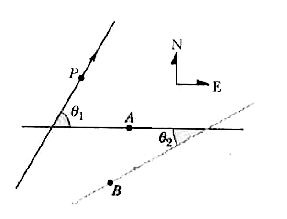A truck increases its speed at constant rate of 0.1m/s2 and it passes over a semicircular bridge of radius 40 m. At the time car reaches the top of the bridge, its speed is 2m/s. What are the magnitude and direction of the to total acceleration vector at this moment?

The truck moves long a curved path with variable speed. Thus, the truck has both tangential and radial acceleration. The radial acceleration is given by ar=v2/R, with v=2m/s and R=40m. The radial acceleration vector is directed straight downward, and the tangential acceleration vector has magnitude 0.1m/s2 and its is horizontal.
Calculation: Let us calculate the radial acceleration:
ar=v2R=(2m/s)240m=0.1m/s
Now
|¯a|=√a2r+a24=√2(0.1)m/s2
Which is the magnitude of →a. Now, the angle ϕ between →a and the horizontal is given by
ϕ=tan−1(arat)=45∘

Topper's Solved these Questions
- BOOK - RESNICK AND HALLIDAYCHAPTER - CIRCULAR MOTIONEXERCISE - PROBLEMS56videos
CIRCULAR MOTION
- BOOK - RESNICK AND HALLIDAYCHAPTER - CIRCULAR MOTIONEXERCISE - PRACTICE QUESTIONS(SINGLE CORRECT CHOICE TYPE)40videos
CIRCULAR MOTION
- BOOK - RESNICK AND HALLIDAYCHAPTER - CIRCUITSEXERCISE - Practice Questions (Integer Type)3videos
CIRCUITS
- BOOK - RESNICK AND HALLIDAYCHAPTER - CURRENT AND RESISTANCEEXERCISE - Practice Questions (Integer Type)3videos
CURRENT AND RESISTANCE
Similar Questions
In the overhead view of Fig. 4-40, Jeeps P and B race along straight lines, across flat terrain, and past stationary border guard A. Relative to the guard, B travels at a constant speed of 25.0 m/s, at the angle θ2=30.0∘. Relative to the guard, P has accelerated from rest at a constant rate of 0.400m/s2 at the angle θ1=60.0∘. At a certain time during the acceleration, P has a speed of 40.0 m/s. At that time, what are the (a) magnitude and (b) direction of the velocity of P relative to B and the ( c) magnitude and (d) direction of the acceleration of P relative to B?
 View Solution
View SolutionA particle is performing circular motion of radius 1 m. Its speed is v=(2t2)m/s. What will be magnitude of its acceleration at t=1s.
View Solution
Knowledge Check
- Question 1 - Select One
A particle is moving on a circular path of 10 m radius. At any instant of time, its speed is 5ms−1 and the speed is increasing at a rate of 2 m s2. The magnitude of net acceleration at this instant is
A5ms−2B2ms−2C3.2ms−2D4.3ms−2 - Question 2 - Select One
A car is moving on a circular road of radius 100m. At some instant its speed is 20m/s and is increasing at the rate of 3m/s2. The magnitude of its acceleration is
A2m/s2B3m/s2C5m/s2D4m/s2 - Question 3 - Select One
A car is moving with speed 20ms−1 on a circular path of radius 100 m. Its speed is increasing at a rate of 3ms−2 . The magnitude of the acceleration of the car at that moment is
A1ms−2B3ms−2C4ms−2D5ms−2
A roller coaster car has mass of 1300 kg when fully loaded with passengers. As the car passes over the top of a circular hil of radius 20m, its speed is not changing. At the top of the hill, what are the (a) magnitude FN and (b) direction (up or down) of the normal force on the car from the track if the car's speed is v=11m/s? What are (C) FN and (d) the direction if v=14m/s?
View SolutionA car is moving with speed of 2ms−1 on a circular path of radius 1 m and its speed is increasing at the rate of 3ms(−1) The net acceleration of the car at this moment in m/s2 is
View SolutionA car is moving with speed 30m/sec on a circular path of radius 500 m . Its speed is increasing at the rate of , 2m/sec2, What is the acceleration of the car
View SolutionA motor car is travelling 20m/s on a circular road of radius 400 m. If it increases its speed at the rate of 1m/s2, then its acceleration will be
View SolutionA motor car is travelling at 60m/s on a circular road of radius 1200m. It is increasing its speed at the rate of 4m/s2. The acceleration of the car is:
View Solution

